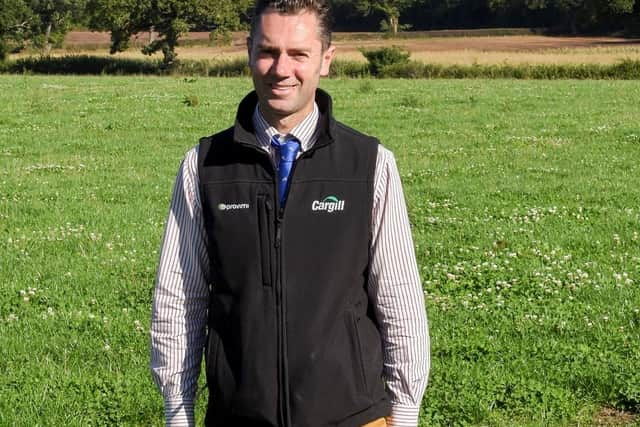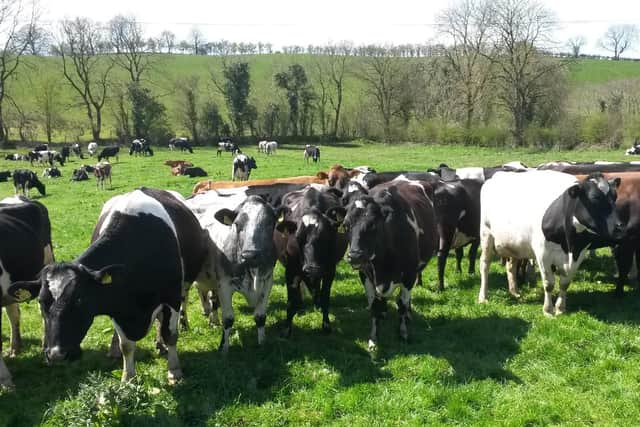Bucking the butterfat dip - advice from Cargill
and live on Freeview channel 276
With high bought-in feed costs and milk prices easing back, the dip in milk quality isn’t particularly welcome on our dairy units.
“Farmers will be keen to protect margins,” says Cargill’s Philip Ingram. “So it’s worth protecting milk quality at this time of year, and through the grazing season.
Advertisement
Advertisement
“Typically, at turnout, butterfat levels can drop by as much as 0.5% which can mean significant price reduction on many milk contracts. And we’ll typically see butterfat decline by 0.35% in grazed herds in Northern Ireland.”


He adds that this dip in milk quality can fall fairly rapidly after turnout in some herds but this is actually more likely during the second or third round of grazing, often between three and nine weeks after initial turnout.
“The two main factors responsible for this fall are the high oil content in fresh grass and the fibre in fresh grass,” adds Dr Ingram. “This high oil content of grass, which is even more elevated in some of the newer varieties, makes the unsaturated fat content of the grazing diet about 50% higher than the typical winter ration.
“And fresh grass has low structural, highly digestible fibre in fresh grass that causes a reduction in rumen Ph and creates acidic conditions.
Advertisement
Advertisement
“When these two factors combine and create a perfect storm in the cow’s rumen and disrupts the normal pathways used by the cow to produce butterfat,” he adds.


But dairy farmers can help to avoid this and keep butterfat levels on track through the grazing periods by using specialised buffers that go beyond controlling rumen pH and will help to counter the negative effects of the grass on butterfat production.
These buffers are also effective when added to diets where highly digestible, high energy silages are included in the ration, such as with multi-cut systems or where co-products are fed that are high in oil.
Prevention vs cure
“Equaliser Cream, for example, is particularly effective because it works as a buffer in maintaining rumen pH and also normalises the oil conversion pathways and protects butterfat production. It has a two-pronged approach and prevents rather than ‘cures’ the problem.”
Advertisement
Advertisement
“Most buffers tackle rumen pH as a means of helping to prevent milk fat depression, but they are not consistently effective. Instead, Cream has key ingredients to help reduce the impact of the high oil content of grass on milk fat.”
Recent trial results using the specialist Equaliser Cream buffer on 25 UK and Irish dairy farms in 2021 and 2022 have shown that the product’s two-pronged attack, that maintains rumen pH and normalises the oil conversion pathways, can prevent the butterfat dip.
Thirteen farms introduced Equaliser Cream early, before the usual dip in butterfat, and 12 farms introduced it after experiencing low milk fat. Rates used were between 75g and 150g per cow per day, and the proportion of grazed grass in the diet ranged from 0% to 75%.
The 13 farms introducing the buffer early had the best response with an average improvement in butterfat of 0.4% in May, compared with the same month in the previous year.
Advertisement
Advertisement
The 12 farms feeding the buffer after milk fats dropped saw an improvement within a week of 0.33%, with an average increase in one month of 0.51%.
The average financial benefit of adding Equaliser Cream to diets of the 25 commercial dairy herds monitored in 2021 and 2022 was 51p per cow per day, and for an average herd of 155 cows, this added £2,412 per month based on milk prices for the farms at the time of the trial.
“The response to Cream is rapid,” says Dr Ingram. “Increases in butterfat typically happen within days of introducing Equaliser Cream and butterfat will climb back above 4% in many cases. This improvement is usually reflected in the milk cheque within the month, that the increased price more than pays for the cost of the product.”
Management plays a part too in protecting butterfat. Lush, green grass will have the highest oil content, and the higher the leaf-to-stem ratio, the higher the oil content of the grass, so grazing management needs to be mindful of this.
Advertisement
Advertisement
“Every season is different, and early March saw a sharp cold spell and snow. But the dip in butterfat will always be a threat in spring and summer. Acting now will help prevent this and protect the milk cheque.”